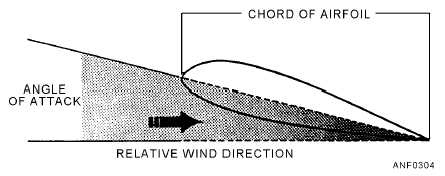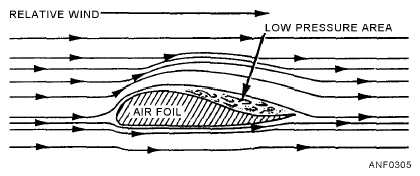upper surface of the airfoil has camber to it, the flow
over its surface is disrupted. This disruption causes a
wavelike effect to the airflow. The lower surface of the
airfoil is relatively flat. The airflow across its surface
isn't disrupted. Lift is accomplished by this difference
in the airflow across the airfoil.
The shaded area of figure 3-5 shows a l ow-pressure
area on the airfoil's upper surface. This low-pressure
area is caused by the air that is disrupted by the camber
of the airfoil, and it is the key t o lift. There is less
pressure on the top surface of the airfoil than there is on
the lower surface. The air pressure pushes upward o the
lower surface. This difference in pressure causes the
airfoil to rise. Now, you know that lift is developed by
the difference between the air pressure o n the upper
and lower surfaces of the airfoil. As long as there is
less pressure on the upper surface and more pressure on
the lower surface of an airfoil, an aircraft has lift. Lift is
one of the forces affecting flight.
Q3-5.
What happens when the relative wind strikes
the leading edge o f a n airfoil?
Q3-6.
Describe how lift is developed.
FORCES AFFECTING FLIGHT
LEARNING OBJECTIVE:
Recognize the
four primary forces acting on an aircraft.
An aircraft in flight is in the center of a continuous
battle of forces. The conflict of these forces is the key t o
all maneuvers performed in the air. There is nothing
mysterious about these forces—they are definite and
known. The direction in which each acts can be
calculated. The aircraft is designed to take advantage of
each force. These forces are lift, weight, thrust, and
drag.
LIFT
Lift is the force that acts in an upward direction to
support the aircraft in the air. I t counteracts the effects
of weight. Lift must be greater than or equal to weight if
flight is to be sustained.
WEIGHT
Weight is the force of gravity acting downward on
the aircraft and everything in the aircraft, such as crew,
fuel, and cargo.
THRUST
Thrust is the force developed by the aircraft's
engine. It acts in the forward direction. Thrust must be
greater than or equal to the effects of drag for flight to
begin or to be sustained.
3-3
Figure 3-4.—Angle of attack.
Figure 3-5.—Airflow across an airfoil.



